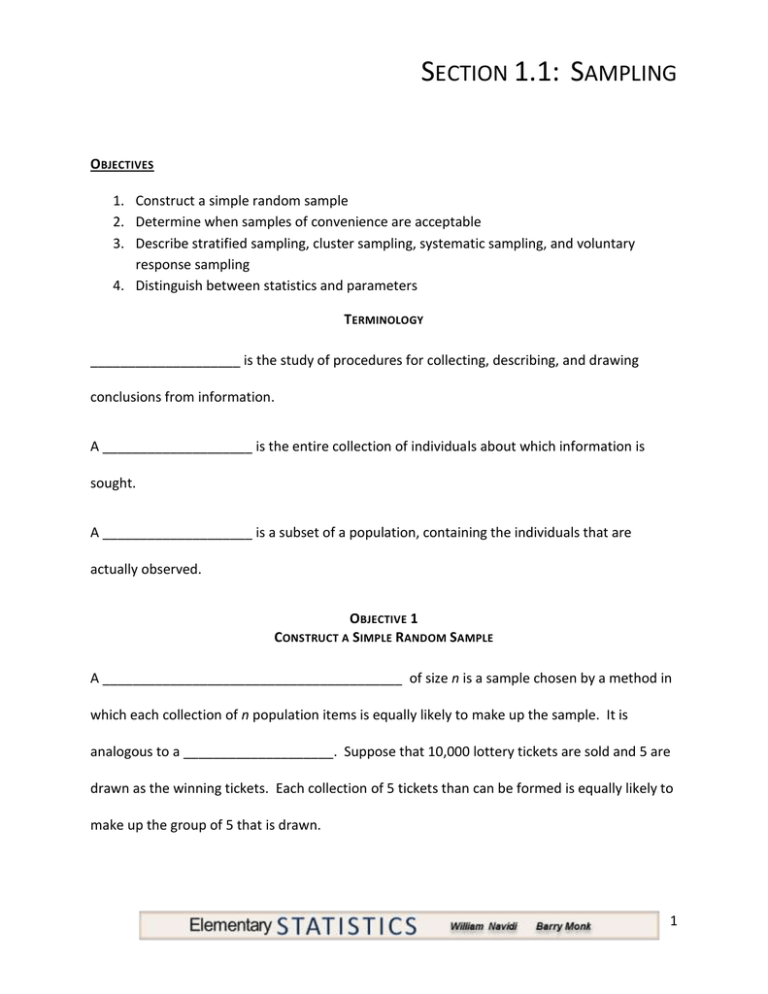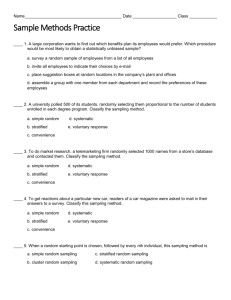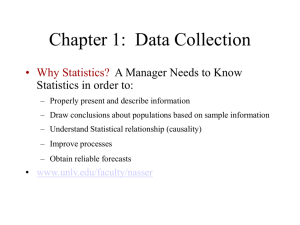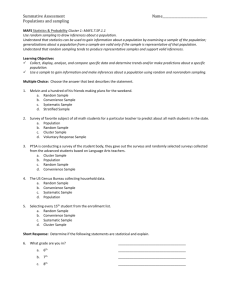Stratified Random Sampling
advertisement

SECTION 1.1: SAMPLING OBJECTIVES 1. Construct a simple random sample 2. Determine when samples of convenience are acceptable 3. Describe stratified sampling, cluster sampling, systematic sampling, and voluntary response sampling 4. Distinguish between statistics and parameters TERMINOLOGY ____________________ is the study of procedures for collecting, describing, and drawing conclusions from information. A ____________________ is the entire collection of individuals about which information is sought. A ____________________ is a subset of a population, containing the individuals that are actually observed. OBJECTIVE 1 CONSTRUCT A SIMPLE RANDOM SAMPLE A ________________________________________ of size n is a sample chosen by a method in which each collection of n population items is equally likely to make up the sample. It is analogous to a ____________________. Suppose that 10,000 lottery tickets are sold and 5 are drawn as the winning tickets. Each collection of 5 tickets than can be formed is equally likely to make up the group of 5 that is drawn. 1 SECTION 1.1: SAMPLING E XAMPLE : A physical education professor wants to study the physical fitness levels of 20,000 students enrolled at her university. She obtains a list of all 20,000 students, numbered from 1 to 20,000 and uses a computer random number generator to generate 100 random integers between 1 and 20,000, then invites the 100 students corresponding to those numbers to participate in the study. Is this a simple random sample? S OLUTION : E XAMPLE : The professor in the last example now wants to draw a sample of 50 students to fill out a questionnaire about which sports they play. The professor’s 10:00 am class has 50 students. She uses the first 20 minutes of class to have the students fill out the questionnaire. Is this a simple random sample? S OLUTION : 2 SECTION 1.1: SAMPLING OBJECTIVE 2 DETERMINE WHEN SAMPLES OF CONVENIENCE ARE ACCEPTABLE SAMPLES OF CONVENIENCE In some cases, it is difficult or impossible to draw a sample in a truly random way. In these cases, the best one can do is to sample items by some convenient method. A ________________________________________ is a sample that is not drawn by a welldefined random method. E XAMPLE : A construction engineer has just received a shipment of1000 concrete blocks. The blocks have been delivered in a large pile. The engineer wishes to investigate the crushing strength of the blocks by measuring the strengths in a sample of 10 blocks. Explain why it might be difficult to draw a simple random sample of blocks. S OLUTION : PROBLEMS WITH SAMPLE OF CONVENIENCE The problem with samples of convenience is that they may ____________________________ ____________________ in some way from the population. If it is reasonable to believe that no important systematic difference exists, then it is acceptable to treat the sample of convenience as if it were a simple random sample. 3 SECTION 1.1: SAMPLING OBJECTIVE 3 DESCRIBE STRATIFIED SAMPLING, CLUSTER SAMPLING, SYSTEMATIC SAMPLING, AND VOLUNTARY RESPONSE SAMPLING STRATIFIED RANDOM SAMPLING In stratified random sampling, the population is divided up into groups, called strata, then a ________________________________________ is drawn from each stratum. Stratified sampling is useful when the strata differ from one another, but the individuals within a stratum tend to be alike. E XAMPLE : A company has 800 full-time and 200 part-time employees. To draw a sample of 100 employees, a simple random sample of 80 full-time employees is selected and a simple random sample of 20 part-time employees is selected. CLUSTER SAMPLING In cluster sampling, items are drawn from the population in ___________________________. Cluster sampling is useful when the population is too large and spread out for simple random sampling to be feasible. 4 SECTION 1.1: SAMPLING E XAMPLE : To estimate the unemployment rate, a government agency draws a simple random sample of households in a county. Someone visits each household and asks how many adults live in the household, and how many of them are unemployed. What are the clusters? Why is this a cluster sample? SYSTEMATIC SAMPLING In systematic sampling, items are ordered and every kth item is chosen to be included in the sample. Systematic sampling is sometimes used to sample products as they come off an assembly line, in order to check that they meet quality standards. E XAMPLE : Automobiles are coming off an assembly line. It is decided to draw a systematic sample for a detailed check of the steering system. The starting point will be the third car, then every fifth car after that will be sampled. Which cars will be sampled? S OLUTION : 5 SECTION 1.1: SAMPLING VOLUNTARY RESPONSE SAMPLING Voluntary response samples are often used by the media to try to engage the audience. For example, a radio announcer will invite people to call the station to say what they think. Voluntary response samples are never reliable for the following reasons: People who volunteer an opinion tend to have _____________________________ ____________________ than is typical of the population. People with negative opinions are often ____________________ to volunteer their response. 6 SECTION 1.1: SAMPLING OBJECTIVE 4 DISTINGUISH BETWEEN STATISTICS AND PARAMETERS A ____________________ is a number that describes a sample. A ____________________ is a number that describes a population. E XAMPLE : Which of the following is a statistic and which is a parameter? 57% of the teachers at Central High School are female In a sample of 100 surgery patients who were given a new pain reliever, 78% of them reported significant pain relief S OLUTION : The quantity “57%” is a ____________________. The quantity “78%” is a ____________________. 7 SECTION 1.1: SAMPLING YOU SHOULD KNOW … What is Statistics The difference between a population and a sample What is a simple random sample When samples of convenience are acceptable The differences among: o Stratified sampling o Cluster sampling o Systematic sampling o Voluntary response sampling The difference between a statistic and a parameter 8









